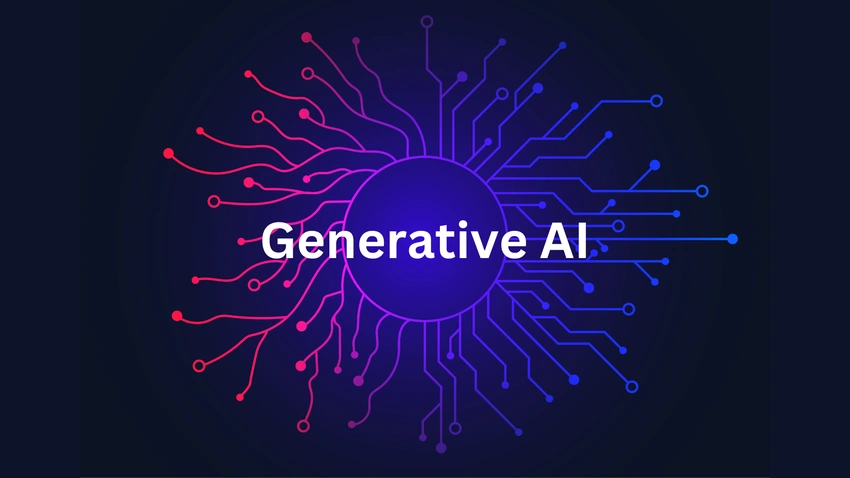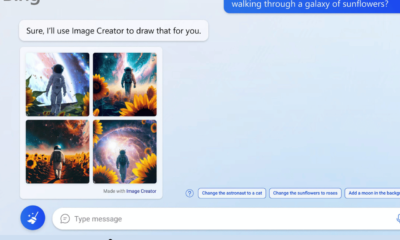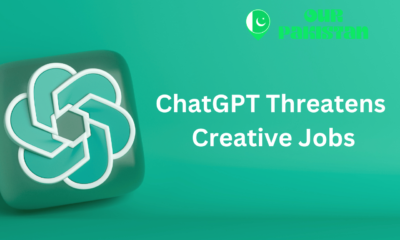Technology
These AI Tools Must be In your Daily Use
Published
3 months agoon
By
Aleezay
There was a time when calculators and computers were considered to be the very latest in technology. We have come a long way since then, when technology had just begun to be accepted. There is no doubt that we are still on the cusp of new and exciting innovations and people are constantly finding different ways to use them for their benefit. One such technology that has already made a monumental impact on our lives and is set to change the way we live in the future is Artificial Intelligence. AI is a rapidly growing and dynamic field with a very rich history but is still developing and changing, and its impact is seen on a daily basis. This technology has been with us for years, but it is only now that we are getting used to and understanding what can be done with it. Here we will take a closer look at what exactly AI is, and the impact it has on our daily lives.
1.1. What is Artificial Intelligence?
The issue of insightful conduct started with an electronic PC in the 1940s. Many simulated programs were created to study human insight. Rationale based AI and its allied fields were influenced by this time. The next phase is developing programs that can learn from their surroundings. A film called A.I. Artificial Intelligence explored the idea of machines having desire and will. AI is the clever development of software and machines. It aims to make machines “intelligent” by simulating cognitive abilities. The definition of AI often excludes tasks that machines can do.
1.2. Importance of AI in Daily Life
Even smartphones are getting smarter and smarter with the help of artificial intelligence. Voice recognition, language translation, face detection, social media, organization of emails, maps, games, etc. are basic facilities available on smartphones that use artificial intelligence techniques. In fact, the new Siri, a personal assistant intelligent agent, is the most popular example of AI on the iPhone. Social apps also use AI with face detection features and image tagging, where we get many similar faces and images grouped together. AI is also useful in developing web search engines to provide optimized search results to end users.
AI has many functionalities and techniques that are used in daily life. AI and robotics are designed for video games, where many learning techniques have been employed to create non-player characters. Music, audio, and robotics are the most useful fields for humankind. They include the treatment of hearing impairments, music composition tools, and making the brain much sharper. There are many animation tools, software, and mobile applications that aid many people. For example, there are many educational mobile apps that are interactive and kids love to learn from them. These apps are specially designed using AI.
Artificial intelligence is already part of our lives and will continue to be in the future. It’s hard to understand and realize that we are using artificial intelligence in our day-to-day life. AI can work for games, entertainment, smartphones, social media, and more. AI has a great impact on the betterment of human life through development in various fields, making the environment much safer and reliable to live in.

2. AI Tools for Productivity
If your day is driven heavily by schedules and appointments, utilizing smart apps that allow you to schedule and optimize your time better is an important addition to your productivity system. AI powered scheduling apps analyze your habits in order to better optimize a schedule that aligns with your energy and work patterns. For example, aCalendar is an app that uses AI tools to analyze the exact amount of time you need to complete tasks, and then fits them into your schedule accordingly, ensuring that you have time to complete everything and are not left with excess time. This app is actually an AI application on Android phones that has received a 4-star rating. Another app, Tempo, is an iOS app that is an intelligent calendar that reads your messages so you never need to search for the right date, time or contact. It also prepares you for your upcoming meetings by showing you relevant emails and documents on your attendees and locations. An assistant on the app can give you notifications and travel time and tell you how to avoid being late. All of these AI applications increase workflow efficiency, and make sure you can be punctual and well prepared for your appointments and tasks.
2.1. AI-Powered Virtual Assistants
AI-Powered Virtual Assistants in the academic book Big Data Management. This passage is particularly thorough and helps illustrate the potential and current understanding of AI virtual assistant technology. The recent success of AI and the availability of vast amounts of data has given rise to intelligent virtual assistant (IVA) technology. Using both natural-language processing and machine learning algorithms, chatbots and IVAs can understand user intent and hold natural two-way conversational interactions. Typically, chatbots are single purpose and follow fixed conversation paths, but AI-enabled IVAs are able to reason about an answer and choose the next best action within the problem space. At present, most IVAs parse the user’s input to form a solid query and perform an information retrieval for an answer. This clarification and discovery understanding for conversational interactions is still a work in progress with the goal to completely eliminate the need of decision-action trees for each possible problem space.
Ideally these virtual assistants can use AI deep learning to understand user intent and hold a natural conversation towards a goal helping optimize the user’s time. While virtual assistants like Google Home and Amazon Echo struggle to hold conversations beyond 10 minutes, the future holds great promise to improving these conversational interactions.
Between 2016 and 2017, 30% of companies began experimenting with AI creating virtual assistants and 24% more plan to experiment with it in the future. This data is likely to reflect a growing industry around this technology as it continues to improve taking over many tasks and improves customer service. These figures come from a 2016 US company survey. Results with similar figures coming from a random 2017 survey. A decent number of companies now are looking at virtual assistants as a competitive advantage, many citing that it’s an integral part of their branding and customer experience in the future. This may be the case as AI continues to improve and new features will become available.
Some examples of virtual assistant technology with AI: Amazon’s Alexa using Tone Analyzer to analyze how to better communicate with users. RealEyes using the Watson API to understand user data to give them the most realistic answer and giving insight to companies about their clients. Spirit.ai using the natural language processing API to understand the communication of toxic behavior in games and prevent it. Microsoft’s Cortana utilizing the Watson conversation API to better understand and hold more natural conversations. Using Personality Insights with machine learning technology to improve its accuracy over time.
2.2. Smart Scheduling and Calendar Apps
In the business world, time is money. A handful of scheduling and calendar apps already exist, but those powered by AI offer the promise of facilitating the most efficient use of your time. An example of such a tool is x.ai, a personal assistant who schedules meetings for you. It corresponds with all participants to find a suitable time, taking into account preferences, habits, and the times that the guests are “usually free.” It then coordinates and schedules meetings and can reschedule if something comes up. It can also arrange meeting locations, directions, and other details. An alternative to hiring a human personal assistant, it eliminates the time-consuming task of scheduling meetings, thus freeing up time for the user to focus on other work. An intelligent time management and productivity tracking app, such as Smarter Time, goes a step beyond conventional daily scheduling apps. It runs in the background on your phone or computer and, through an analysis of your activities, it creates a fully automated time sheet. It then uses AI to construct a schedule, optimized for time allocation towards tasks of higher priority. The app continues to learn the user’s habits and make improvements to this process. Another example is Clara, a scheduling app similar to x.ai, but with an added feature in which it analyzes and learns from the user’s scheduling habits. In doing so, it offers suggestions to the user about alternative better times to schedule meetings and how to make more efficient use of time.
2.3. Intelligent Document Management Systems
Any writer or journalist who uses interview soundbites understand the need to get them transcribed quickly and accurately. In the past, writing out interviews or dropping them into a paid audio to text software were the only options, both which taking a substantial amount of time. Today there are a few, with the accuracy of most voice recognition software it’s usually more convenient to simply record an interview and use a free service such as Google Docs voice typing or Apple dictation and let voice recognition do its best. But for AI, Verbit and Otter are both up and coming voice recognition and transcription services. Otter offers “smart notes.” Within the app the user can search and organize the transcribed content from interviews and lectures. Coming soon Otter will be giving summaries and providing information during meetings with the use of AI. Can you teach an AI to transcribe? I’m not sure, but Otter plans to improve by indexing and recognizing more words and phrases from technical and specialty vocabularies in the future.

Evernote uses AI to not only organize documents and files, but to recognize your writing and document what it is you’re actually trying to accomplish. It’s something that the human mind can do naturally but often gets lost in translation when put into words. Evernote automatically adds tags to your notes based on content, so when you go back you can search something simple yet vague like “ideas” and find notes which you’ve written up, but forgot to tag. Evernote doesn’t just stop there, the app has employed IBM’s Watson AI to give educated guesses and automatic summaries and suggested content. Watson’s next step may take over to give automated consultations on legal firms using AI. Ulysses and Scrivener are marketed towards authors and offer a place to write with no restrictions. Both use machine learning to better understand the content you’re trying to write and give suggestions and summaries. Ulysses is intended for more longform, complex documents and Scrivener is for organizing a multitude of small documents which will form something larger.
I’m a sucker for anything AI powered and document management is no exception. The idea of transferring all of my chicken scratch notes and haphazardly thrown together ideas into an organized, coherent string of documents and folders sounds like a dream. For some, all they will ever need is a digital filing folder to keep things organized. Apps like Google Drive, Dropbox, and OneDrive work wonders and the very basics. But for those looking for a step above to turn their raw text into something more meaningful, tools like Evernote, Scrivener or Ulysses are the way to go.
3. AI Tools for Communication
AI-enhanced video conferencing is also developing quickly, providing better video and audio quality between webcams and microphones. AI is constantly being used to alter and refine video call quality to provide the best experience. While the technology is in its infancy, in the future it may be possible to generate realistic-looking avatars from people’s voice and webcam, offering an interesting approach to disguising one’s identity on the web. This kind of technology is also useful for people within countries that have restricted privacy and freedom of speech, being able to talk with others without the fear of being recorded and having real faces being captured.
Voice recognition and speech-to-text tools have been getting increasingly better with the help of AI technology. Speech recognition helps people who have difficulty using their hands to type, while speech-to-text is designed to turn everything that is being said into literal text. This can help people who are hard of hearing or people who are foreign to a language and are struggling to understand everything that is being said. Many programs using this technology can also understand various accents and provide accurate text to reflect it. An example of this is the automatic captions used in YouTube, which has become very accurate as of late.
AI is not only revolutionizing data analysis, but also the way we communicate with each other. AI-powered language translators have been used for a while now, making it easier for people from different countries to communicate with each other. With the power of AI, these new language translators can now accurately translate one person’s voice into a different language. This is especially helpful for tourists who are unfamiliar with the country’s native language and want to communicate with its people. AI translators also have offline capabilities, giving massive potential for this technology to help people communicate from all over the world.
3.1. AI-Powered Language Translators
Another popular translation tool comes in the form of browser plugins. These are very handy in case of reading some site in another language. The tool detects the language and asks for the conversion in the default language. One such example is the IM Translator. The recent models have shown fitting in the AI algorithms in the browser form itself, thus avoiding unnecessary uploads and downloads of data. A very popular AI form plugin has been the Grammarly tool. Though not a language translation tool, it provides context-based synonyms and general sentence correction suggestions with different language support. This can prove to be a good AI step in the language correction tools.
The most popular application comes in the form of Google Translate. It is a statistical machine translation that uses bilingual text corpora to generate translations. The AI comes in the form where it learns from user inputs and modifies its translation, thus making it more accurate over time. The recent Neural Machine Translation uses deep learning methods to provide near-human translations. This has been made possible because of the deep learning models called sequence-to-sequence models. These models take input sequences from one language and learn to generate output sequences in another language. With the recent method of transfer learning, we can first train the model on some standard text and then fine-tune the model with any specific data. This fine-tuning can prove to be very useful in research papers where technical words can be lost in translation. This kind of translation has proved very efficient for Indian languages.
Language is the first and foremost mode of communication between humans. With the diversification and globalization, everyone is not able to understand every language. Language should not be a barrier for people to understand and communicate. Language translators have been popular tools for a while, and with the recent advancements in AI, they have become very efficient with near-human translations.
3.2. Voice Recognition and Speech-to-Text Tools
Advancements in voice recognition and speech-to-text tools have allowed people to communicate using their spoken words, rather than relying on typing. This is specifically useful for individuals who may have difficulty typing, such as those with disabilities or certain ailments. Dragon is a popular AI-powered speech recognition tool which is tailor-made for those with disabilities. Another tool is ‘Braina’ which uses artificial intelligence to convert your voice into notes, capture your thoughts in real time, and provides an alternative to the traditional typing or writing method. Google’s speech-to-text tool is also a relatively accurate and easy to use tool for translating spoken word to text. This can be used for typing emails, documents, or even using the old-fashioned MSN messenger, allowing constant communication between friends from the luxury of speaking data in a written form.
3.3. AI-Enhanced Video Conferencing Platforms
There are many platforms out there that offer video conferencing for virtual teams. These range from free offerings such as Google+ Hangouts to enterprise-level tools like Cisco WebEx. However, AI video conferencing is still in its early stages, and one company making great strides in the field of AI is Zoom AI. Zoom is a video conferencing platform that includes the Zoom Presence application, which offers immersive video telepresence. It uses AI to create a virtual meeting with people from anywhere in the world, with collaborative tools on a shared virtual stage. Although not ready yet, with further advancements in AI, this will be the future of video conferencing for virtual teams. Admittedly, it sounds quite futuristic and at this point in time it’s not clear if it will take off, but it’s an interesting concept and could potentially offer a much-enhanced video conferencing experience.
One major communication tool is video conferencing, and with AI on the rise, this means that we now have AI-enhanced video conferencing platforms. Video conferencing has become an essential part of the business world over the past decade. Globalization and the rapid increase in international business transactions have led to the widespread use of virtual teams. The high cost of travel, a sluggish world economy, and the speed of business makes virtual teams an attractive alternative. However, virtual teams are heavily reliant on technology that facilitates communication; more specifically, tools that support concise real-time exchanges and that help to build shared understanding. Video conferencing is the most powerful communication tool that virtual teams use. With HD video and Dolby Voice, it’s almost as good as being there. Sharing a virtual face-to-face makes all the difference. But these days, video conferencing is not just about seeing and hearing, and that’s where the AI comes in.
3.4. Chatbots for Customer Support
But what if sometimes you contact customer support, and the person on the other side is also a bot? AI in customer support wouldn’t consider such a far-off idea. Chatbots are now common for customer service, and the use of AI can make them much more useful. For one, natural language processing enables the chatbot to understand and respond to the customer, in context, in their language. It can even personalize responses using data about the customer. AI chatbots can be trained to be more effective at engaging the customer, and while they will never replace human customer service, there’s strong potential for time and resource savings by using them. Some companies supply virtual customer support agents, placing them in 3D simulated environments that can resemble real offices. The virtual agent can observe and learn from human behavior and operations in these environments to continuously improve its AI. It’s an interesting idea, but it may be sometime before we see widespread adoption of it.
4. AI Tools for Personalization
Currently, shopping online or scrolling through our social media feeds are personal and unique experiences for everyone. This is the effect of AI-based personalization features which record and process user information to cater the experience specific to user behavior.
From the array of personalized experiences, a standout effective and productive AI tool is the Netflix recommendation engine which the video streaming service boasts is “an algorithm that helps you sort through the vast catalog of content”. This engine accumulates and stores an indefinite amount of data from all of its subscribers, then sorts and compares data sets. These can range from MPAA movie ratings to genre, actor, director, and footage length and almost every other element in a movie. So for one user, a list of top ten action movies will be completely different from another user also requesting the same list. This may not seem like an informative tool for personal development or productivity, but the concept stands as a great and powerful technique that every experience the user has on Netflix is different from everyone else. Another great AI personalization tool hails from Chubbs, the largest of the USA’s three nationwide credit reporting companies. They use an AI program to customize their user experience to suit many varying factors such as credit card type, homeowner status, time since last insurance claim, and much more. This has led to a 20% increase in consumers building quotes and a 10% lift in consumers actually purchasing policies.
4.1. AI-Driven Recommendation Systems
Right from recommending a good movie to a perfect match for marriage, an AI-based recommendation system provides information and suggestions to the users. In the context of helping users make choices, often referred to as a decision support system, a recommender system is any tool or technique that attempts to provide, automatically or interactively, information with the purpose of recommending items, products, services, or other recommendations useful to the user.
Designing a good recommender system is a difficult task. Information in the system will widely vary and can be anything from music, movies to clothes. Making things more complicated, the context from which to base recommendations may be difficult to assess and the preferences of users may change continually. Given advances in computer and internet technology, providing recommendations has become an important area of research due to the sheer volume of available information and the increase in possibilities to make automated product comparisons.
The field of recommender systems has had many successes recently thanks to advances in adapting standard Artificial Intelligence (AI) and Machine learning techniques to the problem. Industry has also found that a good recommendation strategy can have a substantial effect on customer satisfaction and has led to well-known successes such as Amazon’s implementation. Due to the variety of possible recommendation methods, one technique may work well for certain types of information but may be unsuitable for others, and it is often a combination of methods that is deployed to provide robust recommendations.
4.2. Personalized News and Content Aggregators
These tools aim to help you make sense of all the news and information out there. Each one does this in a different way, so it’s worth trying out a few to see which works best for you. Feedly gives you a single place to read all the news you rely on to think, learn, and keep ahead. It organizes all the sites you rely on for content, lets you read the content of each site within the app, and curates content for you based on trending stories in your favorite sources. You can share, save and search articles too. Pricing: Free and paid plans, starting at $6 per month. Flipboard is a news aggregator and social network aggregation company. It allows you to read the web in a custom-tailored magazine. In addition to offering a personalized news experience for you, it also allows you to create and share your own magazine, by saving articles and curating your own collection. Pricing: Free. Google News is a news aggregator aimed at organizing all the world news. It offers news from more than 50,000 news sources and publications. Using the power of AI, it helps you organize all of the new information you have coming in by showing an uncluttered UI, fresh link of news stories and areas for news recommendations that are constantly updated. You can access it on the web, get an app, and even a smart news display at home. Pricing: Free.
4.3. AI-Powered Music and Movie Recommendations
It is always difficult to decide which movie you want to see. With the amount of genres and selections available these days, sometimes it is just easier to avoid going to the movie store. What if there was a way to find a movie that crossed several different genre types that you like? My sister purchased Netflix. I had never asked her why she decided to get it, but I’m glad she did. I have tried using different online streaming services in the past and also new release kiosks at grocery stores. When I discovered the amount of cross-genre movie selections that Netflix offered, it felt as if the recommendations were automatically generated for me. This is a perfect example of a system that uses AI to improve the movies they suggest to their customers. A system that runs machine learning algorithms takes the information for which movies a customer has watched and rates them, and further uses this information to try and predict other movies the customer would enjoy. The use of AI for movie recommendations does not stop there. Another good example is the recommendation system at Redbox. Did you know that not all Redbox kiosks have the same movie selections? As a way to capitalize on potential revenue, movie studios sometimes create what is called a hot title. A hot title is a new release movie that the studio believes will do very well. In some cases, to obtain more revenue with a company like Redbox, a movie studio will provide the hot title to a kiosk at discounted revenue. With the prediction that the hot title will attract more customers to rent movies from the kiosk, AI developers from Redbox use a recommendation system so that if a customer tries to rent a movie and it is not available at that location, it will suggest a different movie choice and location for the customer.
Trending
-
About Pakistan1 year ago
Iconic Pakistani Personalities Throughout History
-
Online Earning1 year ago
Top 10 Online Platforms for Remote Jobs Earning Opportunities
-
About Pakistan12 months ago
Minar e Pakistan: The Iconic Monument of Pakistan
-
Technology12 months ago
The Rise of ChatGPT in the Workplace
-
About Pakistan1 year ago
Colorful Festivals: Celebrations in Pakistan
-
News & Affairs1 year ago
Pakistan’s Economic Outlook: Opportunities & Challenges
-
About Pakistan1 year ago
Exploring Pakistan’s Cultural Diversity
-
Online Earning12 months ago
10 Effective Ways for Online Earning in Pakistan





















